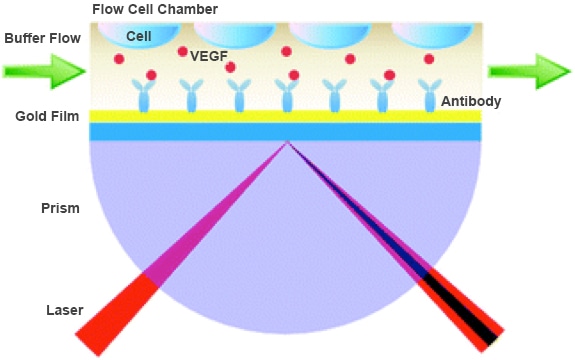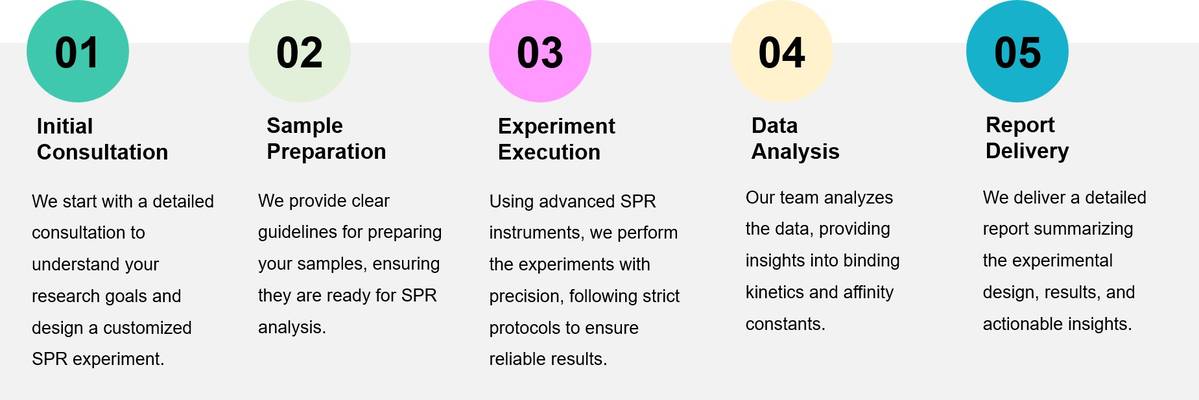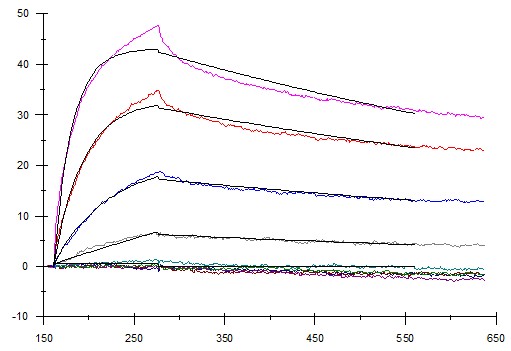Surface Plasmon Resonance (SPR) Service
Background
Introduction
Surface Plasmon Resonance (SPR) is a super handy, no-label method for checking out how biomolecules interact in real-time. It picks up on shifts in the refractive index at a sensor chip's surface, letting you measure the binding between molecules precisely. SPR is often seen as the go-to method for analyzing interactions because it gives you detailed kinetic and affinity data without needing to tweak the molecules.
SPR does its thing by using a certain angle of light to cause a resonance effect on a metal surface, usually gold or silver. When molecules latch on or let go of the surface, it tweaks the angle at which light bounces off-this is the SPR angle. These changes are tracked in real-time, giving you insights into binding kinetics and affinity. The method is super sensitive, able to catch even the tiniest changes in surface mass, which makes it perfect for exploring a variety of biomolecular interactions.
 Fig1. Principle of the SPR Technology. (Liu. et al. 2012)
Fig1. Principle of the SPR Technology. (Liu. et al. 2012)
Applications of SPR

Protein-Protein Interactions
SPR is great for studying how proteins interact. It gives detailed info on how tight the binding is and how fast it happens. This helps in understanding how proteins work together in cells and how they might be involved in diseases.

Drug Discovery
In drug development, SPR helps find and test new drug candidates. It quickly tells you if a drug molecule binds to its target and how strong that binding is. This speeds up the process of finding effective drugs.

Biomarker Detection
SPR can find low levels of biomarkers in complex samples like blood or tissue. This is important for early diagnosis of diseases like cancer. It can spot tiny changes that other methods might miss.

Cell-Based Assays
SPR can also study how cells interact with molecules. This helps in understanding cell signaling and finding new drug targets.
Advantages of SPR
- Label-Free Detection: SPR doesn't need to label the molecules you're studying. This keeps the molecules in their natural state and makes the experiments simpler.
- Real-Time Monitoring: SPR gives you live data on how molecules bind and unbind. This helps you see the interaction as it happens, giving a clear picture of the process.
- High Sensitivity and Throughput: SPR can detect very small amounts of molecules and can handle many samples at once. This makes it great for screening lots of potential drug candidates quickly.
- Versatile Applications: SPR works with all kinds of molecules, from small ones like drugs to big ones like proteins and even whole cells. This makes it a go-to tool for many types of research.
- High-Quality Data: SPR gives reliable and repeatable results. This means you can trust the data and use it to make important decisions in your research.
Inquiry Now
Service Procedure
- Comprehensive Service Workflow:

- Deliverables:
- Detailed Experimental Report
A thorough report outlining the experimental setup, conditions, and analysis of SPR data. This includes essential details like binding affinity (KD), association rate constants (Ka), and dissociation rate constants (Kd), giving you a clear picture of how your biomolecules interact.
- Data Visualization
Detailed graphs and charts displaying SPR signals, dose-response curves, and binding interactions. These visuals make it easy to interpret the data and spot key trends and insights, similar to the binding affinity results we provided in our recent project.
- Actionable Insights
Beyond just the numbers, we provide expert opinions on the SPR findings in line with your research objectives. You'll also get practical suggestions for additional experiments or optimizations, allowing you to make smart choices for your future steps.
- Service Details:
- High-Throughput Screening
Our SPR setup is built for speed and efficiency, handling multiple samples swiftly. It's perfect for large projects, giving you quick results without compromising on accuracy.
- Versatile Assay Buffers
We can run SPR experiments in various buffers, even complex biological fluids. This keeps your experiments close to real-world conditions and maintains the natural state of your biomolecules.
- Real-Time Quality Control
Our SPR platform monitors experiments in real-time, keeping an eye on things like polymerization and precipitation. This instant feedback lets us make quick adjustments, ensuring your data is always reliable.
Inquiry Now
Why Choose Profacgen?
Advanced equipment and technique
Experienced scientific team
Highly reliable and reproducible result
Short turnaround time
Best price in the market
Case Study
Project: SPR Binding Assay for Protein-Antibody Interaction
Background
The project aimed to measure the binding affinity (KD) of protein interactions with antibodies using Surface Plasmon Resonance (SPR). The ligand (protein) was immobilized on a sensor chip, and the analyte (antibody) was injected to interact with the ligand. The goal was to determine the binding affinity (KD) between the protein and the antibody.
Results
Conclusion
The SPR binding assays were successfully completed. The results demonstrated a specific and strong binding interaction between the antigen and Herceptin® (trastuzumab) with a KD of 0.61 nM. This data provides valuable insights into the interaction dynamics and supports further research in protein-antibody interactions.
FAQs
Q: Does SPR require labeling of samples?
A: Nope! SPR is label-free, which means no need to tag or alter your samples. This keeps things simple and preserves the natural state of your molecules.
Q: Can SPR detect low-affinity interactions?
A: Absolutely! SPR is so sensitive it can catch even the faintest interactions. It's perfect for looking at all kinds of molecular pairings.
Q: Is SPR useful for detecting biomarkers?
A: Yes! SPR is fantastic for finding biomarkers in tricky samples. Its precision makes it a top choice for early disease detection.
Q: What kind of support does Profacgen offer with their SPR services?
A: Profacgen is with you from beginning to end. We assist with experiment design, manage the analysis, and help interpret the results. You can trust us to guide you through the entire process.
Resources
See the instruction of surface plasmon resonance (SPR) service. SPR technology has broad application in physics, chemistry and biology. Profacgen provides various types of SPR biosensors for various applications. The sample from costumer for SPR should meet several requirements. Please see detail in the instruction. And our experts will design the experiment according to your specific requirements.
Click here to download the Service Instruction.
Reference:
- Liu C.; et al. Real-time monitoring biomarker expression of carcinoma cells by surface plasmon resonance biosensors. Chem Commun (Camb). 2012;48(84):10389-10391.
 Fig1. Principle of the SPR Technology. (Liu. et al. 2012)
Fig1. Principle of the SPR Technology. (Liu. et al. 2012)




 Fig2. Results of SPR assay.
Fig2. Results of SPR assay.